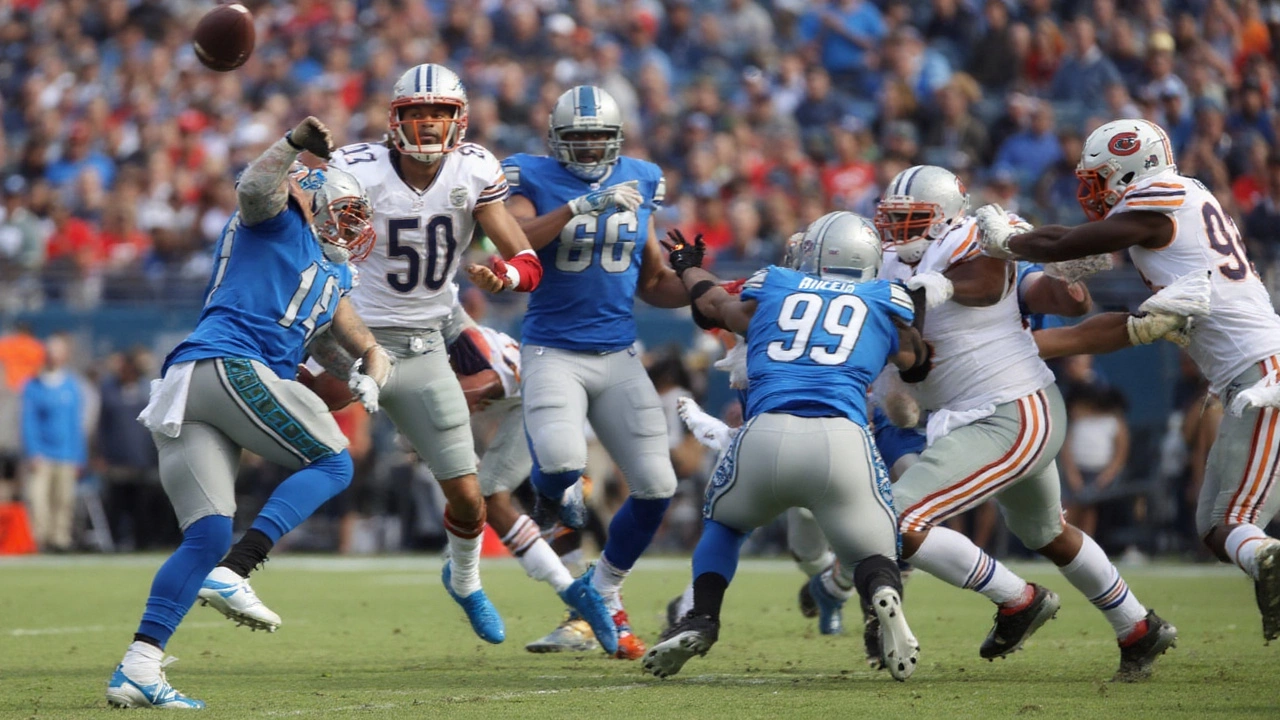- 0
Goff sets the tone in a 52-point romp
Fifty-two points and five touchdown passes—Detroit didn’t just win; it overwhelmed Chicago. In a 52-21 beatdown at Ford Field, the Detroit Lions looked every bit like the NFL’s sharpest offense again, and Jared Goff played his cleanest game of the year. He completed 23 of 28 attempts, worked with rhythm from the first snap, and left in the fourth quarter after the outcome was settled.
The opening was ruthless: five plays, 60 yards, touchdown. Detroit used tempo, motion, and a quick shift in formations to keep the Bears in vanilla coverage. From there, Goff lived in the pocket, trusted his first reads when they were there, and calmly progressed when they weren’t. His ball placement—especially on timing throws between the numbers—turned tight windows into layups.
Goff’s command stood out most on third down and in the red zone. He didn’t force throws into traffic, he took the underneath answers when Chicago’s safeties stayed high, and he punished any late rotations. You could see the comfort: efficient footwork, decisive hitches, and no panic under interior pressure. Detroit’s passing game wasn’t just explosive; it was steady, which is far more demoralizing for a defense.
The run game made everything easier. Jahmyr Gibbs gave Detroit the burst to the edge, while David Montgomery nailed the inside lanes with patient reads and downhill finishes. The Bears often played with light boxes to protect against deep shots, and Detroit took the free yards. Those consistent early-down gains kept the playbook open, let the offense stay on schedule, and set up play-action shots that landed.
On the perimeter, Amon-Ra St. Brown did what he always does: win on option routes, find soft spots against zone, and convert key downs. Jameson Williams stretched the field and threatened leverage before the snap, which forced the Bears to backpedal and gave Goff safer middle-of-field throws. That balance—reliable chain-mover plus vertical stress—left Chicago without clean answers.
The offensive line deserves a game ball on its own. The pocket stayed clean, Goff could hold the ball when he needed to, and the group sorted out stunts and blitz pressure without giving up free runners. When Detroit went heavier to lean on the clock, the line created a push that kept drives alive and drained any hint of a comeback.
Give play-caller Ben Johnson credit for the architecture. His script hit immediately, and he never let the Bears settle into a rhythm. He toggled between condensed formations and spread looks, shifted backs and receivers to isolate matchups, and used motion to reveal coverage. The result was a game where every concept seemed to set up the next one—and Chicago was always a step late.
Why the plan worked—and what it says about Detroit
This wasn’t about one hot quarter. Detroit controlled pace and space for four straight quarters. When Chicago tried two-high shells to limit explosives, the Lions ran into light boxes. When safeties crept down, Goff attacked seams and crossers. That push-pull lives at the heart of modern offense, and Detroit executed it with the kind of timing that buries teams before halftime.
Situational football told the same story. Third downs were manageable because early downs did their job. Red-zone trips didn’t stall because Detroit won leverage at the snap—using motion to create free releases and bunch alignments to force switches. And penalties didn’t derail drives, a quiet but crucial piece when you score at this clip.
Chicago’s defense looked stressed from the first series. The Bears’ linebackers had to honor Gibbs’ speed to the perimeter, which widened interior run lanes for Montgomery. Corners respected Williams’ vertical juice, which opened room underneath for St. Brown and the tight ends on pivots and stick routes. That’s a nightmare combination: defend everything deep and everything short, all at once, while Detroit protects the quarterback.
There’s also the burden of facing a team that can score out of any personnel grouping. Detroit didn’t need gadgetry—just sound structure. When the Lions went heavy, they could mash. When they spread out, they could isolate a weak link. The scheme gave Goff answers before the snap and even cleaner ones after the snap when coverages declared.
It’s easy to fixate on the 52 on the scoreboard, but the near miss on a franchise record might say more. This looked like the group that led the league in scoring last season, only cleaner. The ball rarely hit the ground. The protection was reliable. The run game forced honest fronts. That’s the spine of a contender: you can win shooting matches, but you can also strangle games with balance and composure.
Defensively, Detroit didn’t need heroics because the offense kept stacking points. Allowing 21 is manageable when you’re breaking the half-century mark; more importantly, the offense kept the Bears on the sideline long enough to tilt field position and tempo. That complementary feel—offense dictating terms, defense playing with a cushion—showed up across the middle quarters.
Ben Johnson’s fingerprints were everywhere, but this was a full-unit win. Receivers blocked on the perimeter to spring runs and screens. Backs passed off blitzers cleanly. The line communicated, which killed Chicago’s attempts to manufacture pressure. And Goff’s poise made all of it look easy.
What comes next is simple: reproduce the balance. Teams will try to copy Chicago’s early looks, then abandon them after Detroit punishes the light boxes. Others will test the edges with pressure or play more man to squeeze timing routes. If the Lions keep stacking clean pockets, efficient runs, and precise spacing, the counterpunches won’t land often.
If you’re looking for one number to remember, stick with five: five touchdown passes on 28 attempts. That ratio screams control—no panic, no waste, just ruthless execution. Add in an opening drive that set the tone and a fourth quarter spent protecting a blowout, and you have the blueprint for how Detroit wants to play when it matters most.
Key takeaways from a statement win:
- Jared Goff managed the game and attacked downfield when the coverage allowed it—five touchdowns, minimal risk.
- The run-pass balance forced Chicago into no-win choices and kept the script in Detroit’s hands.
- Amon-Ra St. Brown and Jameson Williams complemented each other perfectly—chains and chunk plays.
- The offensive line neutralized pressure and created lanes all afternoon.
- Ben Johnson’s sequencing of plays turned a hot start into four quarters of control.
Detroit didn’t just beat a division rival; it sent a message. The operation looked polished, the stars played like stars, and the ceiling—judging by how close this got to a scoring record—still feels within reach.

